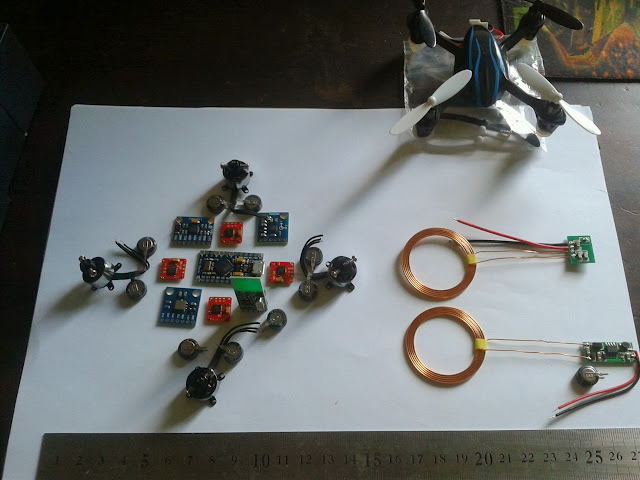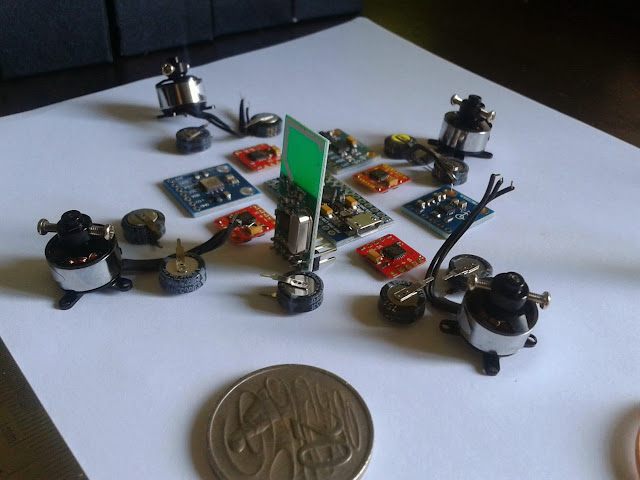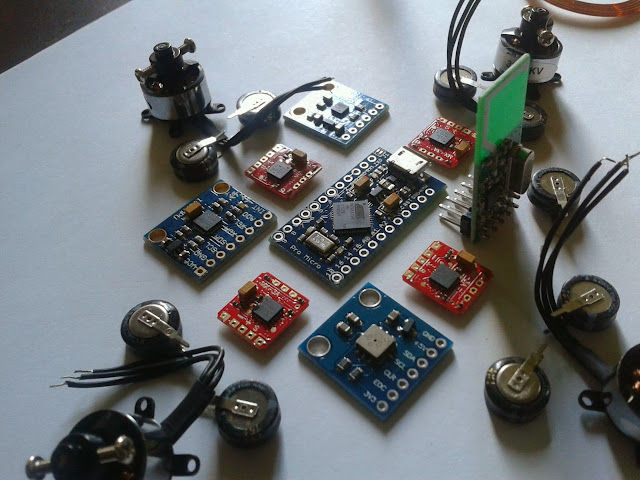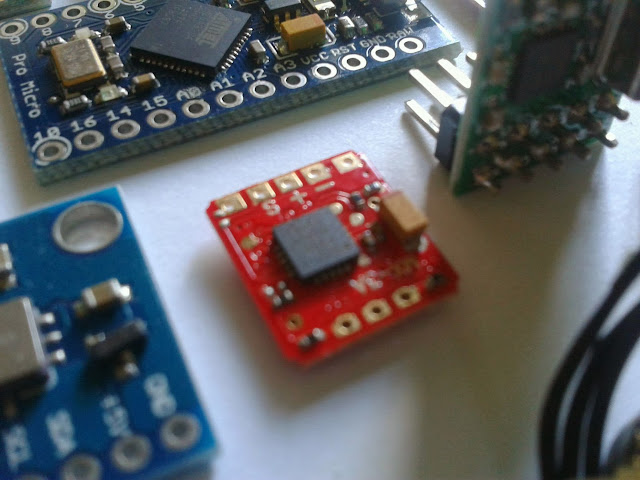Actually, the title is a bit of a tease. I know exactly where they are. But people can't seem to get their head around the coding. And that's holding back demand.
Do you think transistors (and therefore computers) are Boolean devices? Would you be uncomfortable if I told you that's wrong, and easily proved? Which means they are not logical and deterministic machines which will always carry out the same series of instructions given the same program, like they told you. Sorry.
Sure, logically they do. But physically, things are more complicated. I'm sure you guessed that already. If you happen to present a transistor with a gate level that just happens to be a critical 'in-between' voltage, the transistor will not switch into a state representing either zero or one, on or off, but instead goes gray.
The technical term is "metastable", because often it doesn't just sit maddeningly in-between - it balances there and generates white noise, blasting out randomness into the rest of the circuit.
This ambiguity value can propagate, if it matches the metastability of the next transistor. And the next.
Why don't you experience this all the time? Because pretty much every aspect of digital logic design at the physical level is intended to hide it. Big fat specifications with timing diagrams which say you should never present such indeterminate voltages, and if you do then it's your own fault. We have bistable latches, Schmitt triggers, lockup protection, thin films designed to decrease metastability, and design features so core we take them for granted...
Such as the clock. The entire point of a central propagated clock (and all the resources it requires) is to create a moment where all the transistors shout "change places!" and move through their metastable zone before any measurements get made. It is why "clockless logic" has devolved to just redefining what "clock" means.
And if any of these elaborate protections guarding each and every Boolean 'bit' (actually made from rushing flows of billions of electrons sloshing from potential to potential through the bulk silicon) fails for just the tiniest nanosecond, your computer crashes.
That's why they crash. That's what a "hardware fault" is, and why they're so frustratingly random.
It is the underlying reality of your machine asserting itself, in contradiction of your Bool-ish fantasies. You can't get rid of "noise" entirely, because much of it comes from the atoms within the wires your computer is made from. Just ask Benoit Mandelbrot.
The fact we can construct near-perfect self-correcting boolean simulation machines out of piles of reheated sand is really nothing short of a technological miracle. And is taken entirely for granted.
Students of Object Oriented Programming are taught the tenants of the faith: "Encapsulation, Abstraction, Polymorphism". But they think they are virtues, rather than necessary evils. Abstraction in particular gets totally out of control, with over-generalized interfaces that map well to human concepts (as defined by committees) that bear no relation whatsoever to how a real machine actually would perform the task.
It's why "shader" programmers for game engines are a special breed. They have to smash classic linear algorithms into parallel pieces which will fit into the graphics card pipeline. Abstraction doesn't help one whit. It is the enemy of performance.
There's an equivalent in relational database design: "Fourth Normal Form". (Or even Fifth!) Students are taught how to renormalize their database designs to make them more logical, and are graded on it. Then you get to work on real high-performance transactional systems and quickly rip all DB designs back down to second (or first) normal form, because otherwise the system is too slow for words and users get angry.
If you are using abstraction to hide the details of a problem rather than reveal them, you are using it the wrong way around. Encapsulate the code, not the problem. You can't generalize from a sample of one.
This obsessive need to abstract away and deny the underlying machine is why we're very bad at quantum programming, which pretty much by definition is a sneaky way of arranging the dominoes of reality to fall in a certain way. And while reality is playing quantum dominoes, we keep designing programs as if the game is billiard balls.
And when you ask why, the answer is essentially "because it's easier for people to reason by analogy about billiards".
The assumption here is that the point of computer science is to create nice and easy structures for humans to comprehend.
Um... OK.
And that's why you can't have a quantum computer. Because the only metaphor or abstraction that has any value currently looks like this:
Sure, we have names for some of these concepts. "Superposition" and "entanglement" and so forth, but they have common characteristics and behaviours we have yet to find well-rounded words for, that everyone intrinsically understands. Unless you count "timey wimey".
So forget trying to understand Quantum Information Theory in terms of something else. There isn't.
Just bang the wavefunctions together!
Sunday, December 15, 2013
Sunday, December 8, 2013
The Importance of Dreaming
While soldering things together, I get a lot of time to think about the general course of technology and so forth. And I'm now old enough that I've personally seen a large chunk of the story arc. So rather than post a work update, I wanted to get out of my head a thought that's been rattling around for a while, but recent events have solidified.
Let's start with what sounds like the intro to a terrible, tragic joke: What do the the Newtown Shootings and the Space Program have in common? They are both ways an individual can leave their mark on history. I've been learning how Adam Lanza was apparently inspired by previous school shootings, and had newspaper clippings about such events going back a hundred years to one of America's earliest. He learned that such heinous acts were a path to notoriety, to fame, and he was right, because I just said his name, and you know who I mean.
Not too long ago, there were other ways of achieving such fame. You could become an Astronaut, and walk on the face of another world, for example. Granted it was unlikely - the first round of jobs generally went to the upstanding military types who had been kind enough to fight a war on their country's behalf, but the feeling was that soon we might all have the chance to do something that had never been done, to write our own small piece of the new history.
But that doesn't happen anymore. We aspire to efficient repetition, now. There are far less jobs around so new they don't have a name. There's a stagnant stability to our culture, and we've stopped doing the cool stuff because it was too difficult. No Concorde. No Space Shuttle. Not much to replace them. Maybe we'll go back to the moon next decade. Jupiter? Don't make us laugh.
Buzz Aldrin is reduced to punching bloggers in the face.
When the blue-sky options contract and all the papers talk about are the latest tragedy, when the walls of society close in, we lose something. Modern culture's mantra is that fame is all that matters, and if you're not born pretty or sporty in exploitable ways, there aren't many options left. A whole generation destined to die forgotten, ignored, because we withdrew the support structures and funding needed to feed those dreams.
We just passed discovery of the 1000th exoplanet. One seems to have water. There are, literally, new worlds to explore. But we think they're out of reach, so no-one cares.
Let's start with what sounds like the intro to a terrible, tragic joke: What do the the Newtown Shootings and the Space Program have in common? They are both ways an individual can leave their mark on history. I've been learning how Adam Lanza was apparently inspired by previous school shootings, and had newspaper clippings about such events going back a hundred years to one of America's earliest. He learned that such heinous acts were a path to notoriety, to fame, and he was right, because I just said his name, and you know who I mean.
Not too long ago, there were other ways of achieving such fame. You could become an Astronaut, and walk on the face of another world, for example. Granted it was unlikely - the first round of jobs generally went to the upstanding military types who had been kind enough to fight a war on their country's behalf, but the feeling was that soon we might all have the chance to do something that had never been done, to write our own small piece of the new history.
But that doesn't happen anymore. We aspire to efficient repetition, now. There are far less jobs around so new they don't have a name. There's a stagnant stability to our culture, and we've stopped doing the cool stuff because it was too difficult. No Concorde. No Space Shuttle. Not much to replace them. Maybe we'll go back to the moon next decade. Jupiter? Don't make us laugh.
Buzz Aldrin is reduced to punching bloggers in the face.
When the blue-sky options contract and all the papers talk about are the latest tragedy, when the walls of society close in, we lose something. Modern culture's mantra is that fame is all that matters, and if you're not born pretty or sporty in exploitable ways, there aren't many options left. A whole generation destined to die forgotten, ignored, because we withdrew the support structures and funding needed to feed those dreams.
We just passed discovery of the 1000th exoplanet. One seems to have water. There are, literally, new worlds to explore. But we think they're out of reach, so no-one cares.
Tuesday, December 3, 2013
It's Hoverdroid Day!
Jeff Bezos has been making news today with his Amazon Octocopter delivery drones. I do like his prototypes - very heavy on the redundancy.
 |
| Heavy on the Redundancy |
Possibly my favorite comments were by Bill Gates who (never one to give credit for anything, if he can) went almost in one breath from ridiculing the idea as stunt-like and pointless, to musing whether similar technology might not be useful for zooming medicines and messages around the kinds of roadless refugee camps he's become used to dealing with.
Anyway, I don't have the same budget those guys do, so my autonomous flying robot project is much more modest, and still scheduled to happen mostly over Christmas/New Years after I get some other things finished. In one of those synchronicities, the BLDC motors and controllers arrived yesterday along with the Bezos news. Here's all the pieces I have so far:
Apart from a battery and frame, that's all the components for a quadcopter! On the right is an inductive wireless power transfer system I'm hoping to integrate somehow, and at the back is the classic remote-controlled HubsanX4 (clone) that I've learned so much from.
If rulers don't quite give you the scale, here's a coin. (note: somewhat foreshortened...) I'm guessing all the pieces weigh roughly half a chocolate bar. My first autonomous flying robot, filled with experimental software, needs to be incapable of harm or damage. Especially to me. (Because I'm the one who is going to get hit in the head by a confused droid. I do know this.)
That's an Arduino-clone "Pro Micro" with an Atmel '32U4, a MP6050 accelerometer/gyro (same tech as in the 'sonic screwdriver' I just built...) magnetometer "compass", Barometric pressure "Altimeter" (probably optional given my indoors aspirations) and 2.4GHz radio transceiver. These pieces have been slowly turning up for a while now, and I've tested them all individually in other small projects.
The new components I couldn't do this without are the brilliant next generation of tiny ESCs (Electronic Speed Controllers) matched for the equally small motors. These can push 3 Amps each, and interface directly to the microcontroller.
The brushless motors are Turnigy 3000KV, and weigh less than 5 grams. They are stuffed with neodymium magnets, and will last for years - probably outlast everything else, barring physical crash damage.
Oh, in case you're wondering about the small black can-like components, they are 5V 0.33F super-capacitors. All together, THREE FARADS of power supply smoothing will be distributed around the frame, at the points it is needed. That might power the droid for almost half a second - if the battery just fell off. Enough redundancy to soft-land. Perhaps.
So, if you're interested in autonomous quads, I'll be back to this topic very soon. I have two other robots to finish first, though. (They're coming along nicely, but I can't mention one until after Christmas! Shhh!)
Subscribe to:
Posts (Atom)





